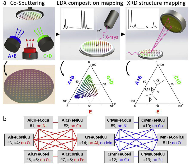Phase selection motifs in High Entropy Alloys revealed through combinatorial methods: Large atomic size difference favors BCC over FCC
High Entropy Alloys are inherently complex and span a vast composition space, making their research and discovery challenging. Developing quantitative predictions of their phase selection requires a large quantity of consistently determined experimental data. Here, we use combinatorial methods to fabricate and characterize 2478 quinary alloys based on Al and transition metals. Phase selection can be predicted for considered alloys when combining the content of FCC/BCC elements and the constituents’ atomic size difference. Mining our data reveals that High Entropy Alloys with increasing atomic size difference prefer BCC structure over FCC. This preference is typically overshadowed by other selection motifs, which dominate during close-to-equilibrium processing. Not suggested by the Hume-Rothery rules, this preference originates from the ability of the BCC structure to accommodate a large atomic size difference with lower strain energy penalty which can be practically only realized in High Entropy Alloys.
- Research Organization:
- SLAC National Accelerator Laboratory (SLAC), Menlo Park, CA (United States)
- Sponsoring Organization:
- USDOE Office of Science (SC), Basic Energy Sciences (BES)
- Grant/Contract Number:
- AC02-76SF00515; 1609391
- OSTI ID:
- 1492457
- Alternate ID(s):
- OSTI ID: 1505635
- Journal Information:
- Acta Materialia, Journal Name: Acta Materialia Vol. 166 Journal Issue: C; ISSN 1359-6454
- Publisher:
- ElsevierCopyright Statement
- Country of Publication:
- United States
- Language:
- English
Web of Science
Critical Review of Chemical Complexity Effect on Local Structure of Multi-principal-Element Alloys
|
journal | August 2019 |
Formation and stability of complex metallic phases including quasicrystals explored through combinatorial methods
|
journal | May 2019 |
Accelerated discovery and mechanical property characterization of bioresorbable amorphous alloys in the Mg–Zn–Ca and the Fe–Mg–Zn systems using high-throughput methods
|
journal | January 2019 |
Formation criterion for binary metal diboride solid solutions established through combinatorial methods
|
journal | January 2020 |
Similar Records
Friction stir gradient alloying: A high-throughput method to explore the influence of V in enabling HCP to BCC transformation in a γ-FCC dominated high entropy alloy
Relative effects of enthalpy and entropy on the phase stability of equiatomic high-entropy alloys






